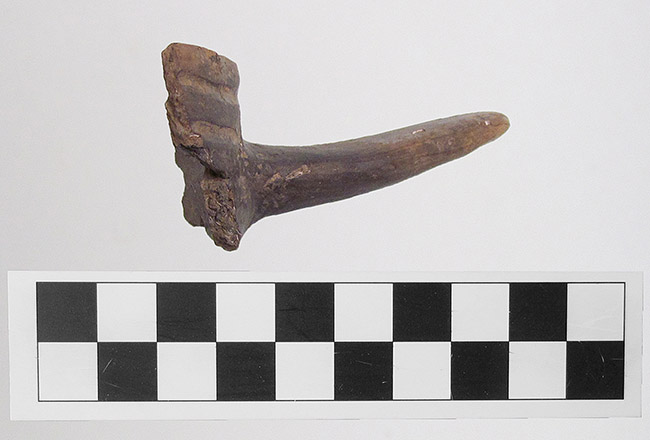Melinda A. Martin (University of Memphis Doctoral Candidate)
Artifact of the Month - May 2021

In the spring of 2008, an excavation of the multiple-component Knappenberger site (3MS53) resulted in the discovery of a Cherry Valley phase beaker handle and rim. Beakers have a variety of styles and shapes but typically have straight or slightly out-slanting sides, a flat bottom, and a protruding cigar-like or tapered handle. These beakers tend to resemble what we would think of as a coffee mug, without the curved handle. Most are undecorated in the eastern Arkansas region, but some are known to contain various detailed iconographic motifs more commonly found in the Illinois River Valley and the American Bottom area. The eastern Arkansas examples are frequently recovered from stratigraphic contexts that suggest an early Mississippi period time frame of ca A.D. 1000–1150. They are referred to as Cherry Valley phase beakers due to the abundant number discovered by Gregory Perino in the early 1960s at the Cherry Valley site (3CS40), located near Cherry Valley, Arkansas.
Perino recovered dozens of beakers of various shapes and sizes during his fieldwork. Additional beaker sites have also been located in eastern Arkansas around Crowley’s Ridge. So, what makes the beaker handle and rim fragment from Knappenberger—a site just miles away from the northeast Arkansas and southeast Missouri border—so unique? One reason is that it is the only known excavated beaker from Mississippi County, making it the easternmost beaker discovery in Arkansas and far from the cluster of known Cherry Valley phase beaker sites.
Archeologists (Crown et al. 2012) performing research on beakers from the American Bottom suggest these vessels may have been used to brew a Native American caffeinated beverage referred to as Black Drink. Using absorbed organic residue analyses, the archeologists detected possible biomarkers of Black Drink, though airborne contaminations from curation shelving may prove an obstacle for definitive positive results. Charles Hudson (2004) in Black Drink: A Native American Tea discusses the importance of Black Drink in daily rituals, purification ceremonies, and as a form of peace offering passed around to guests before political or social dealings.
 Other research (Martin 2019) suggests that these vessels may have been ceremonial paraphernalia associated with the dead’s journey along the Path of Souls, also known as the Milky Way. Iconographic motifs located on beakers near Cahokia may act as a map, depicting the Path of Souls and how to traverse its obstacles to reach the realm of the dead. Although the Cherry Valley beakers do not contain the same iconographic motifs, the message behind the vessel’s use may have been similar.
Other research (Martin 2019) suggests that these vessels may have been ceremonial paraphernalia associated with the dead’s journey along the Path of Souls, also known as the Milky Way. Iconographic motifs located on beakers near Cahokia may act as a map, depicting the Path of Souls and how to traverse its obstacles to reach the realm of the dead. Although the Cherry Valley beakers do not contain the same iconographic motifs, the message behind the vessel’s use may have been similar.
Future absorbed organic residue analyses along with use-wear studies will assist in furthering our knowledge of the function these vessels may have served. Important questions still remain to be answered.
Such questions include: Did the Mississippians who lived at the Knappenberger site have the ability to access Black Drink? If Black Drink was consumed at Knappenberger, how was the non-Arkansas native Ilex vomitoria, the main plant associated with Black Drink, imported? Were these vessels used in purification rituals or as an offering to political and social guests? Was the vessel associated with the importance of making sure one’s spirit could access the Path of Souls and join the ancestors?
For now, we will have to ponder why Mississippians created these small cup-like vessels and how a beaker fragment ended up in northern Mississippi County, miles away from the cluster of Cherry Valley phase beaker sites.
References Cited
Crown, Patricia L., Thomas E. Emerson, Jiyan Gu, W. Jeffery Hurst, Timothy R. Pauketat, and Timothy Ward.
2012. Ritual Black Drink consumption at Cahokia. PNAS 109(35):13944–13949.
Hudson, Charles M.
2004. Black Drink: A Native American Tea. Revised edition. University of Georgia Press.
Martin, Melinda A.
2019. Paths of Power: Assessing the Role of Cahokia-Style Beakers. Master’s thesis, Department of Earth Sciences, University of Memphis, Memphis Tennessee.
 Collections and items in our institution have incomplete, inaccurate, and/or missing attribution. We are using this notice to clearly identify this material so that it can be updated, or corrected by communities of origin. Our institution is committed to collaboration and partnerships to address this problem of incorrect or missing attribution. For more information, visit localcontexts.org.
Collections and items in our institution have incomplete, inaccurate, and/or missing attribution. We are using this notice to clearly identify this material so that it can be updated, or corrected by communities of origin. Our institution is committed to collaboration and partnerships to address this problem of incorrect or missing attribution. For more information, visit localcontexts.org.
 The Arkansas Archeological Survey is committed to the development of new modes of collaboration, engagement, and partnership with Indigenous peoples for the care and stewardship of past and future heritage collections.
The Arkansas Archeological Survey is committed to the development of new modes of collaboration, engagement, and partnership with Indigenous peoples for the care and stewardship of past and future heritage collections.
 The TK Notice is a visible notification that there are accompanying cultural rights and responsibilities that need further attention for any future sharing and use of this material. The TK Notice may indicate that TK Labels are in development and their implementation is being negotiated. For more information about the TK Notice, visit localcontexts.org.
The TK Notice is a visible notification that there are accompanying cultural rights and responsibilities that need further attention for any future sharing and use of this material. The TK Notice may indicate that TK Labels are in development and their implementation is being negotiated. For more information about the TK Notice, visit localcontexts.org.
